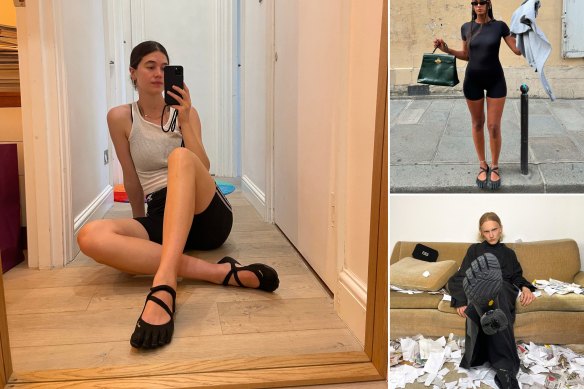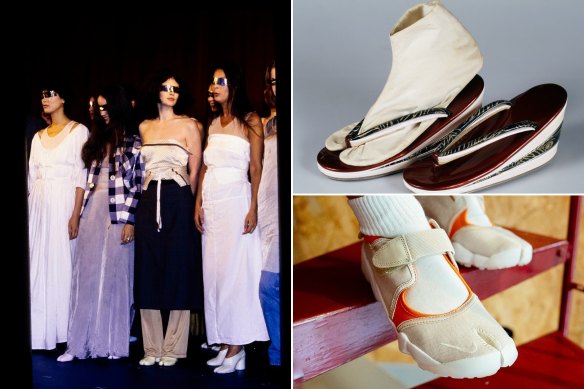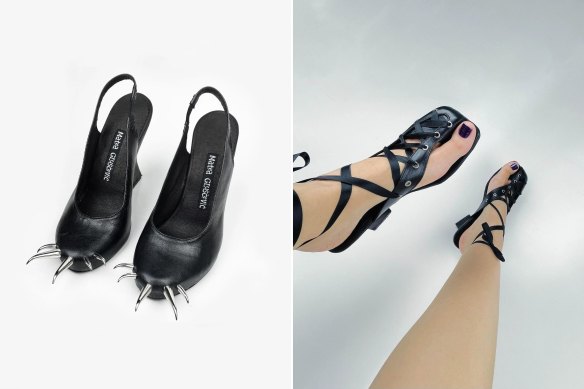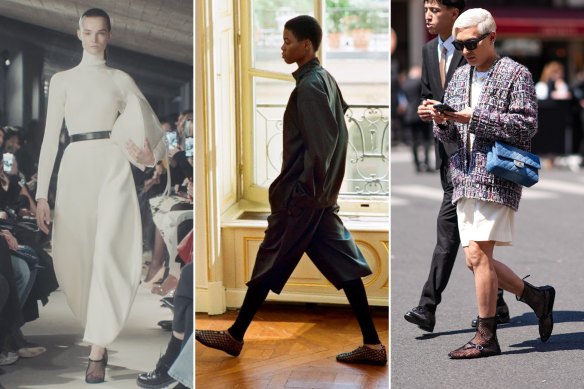There’s no precise word in the English language for the feeling of simultaneous disgust and curiosity. But if there was, dictionaries would surely include Italian brand Vibram’s FiveFingers as an example of something that elicits such a feeling.
The shoes were designed with function, not style, in mind – a “barefoot” shoe for serious runners and hikers. But recently, they’ve been cropping up on the feet of fashion’s well-heeled elite.

Clockwise from left: Georgia Graham in her FiveFingers, influencer Melissa Bon and Balenciaga’s collaboration with Vibram.
Georgia Graham, founder of Threads of Conversation, a podcast and newsletter exploring the stories we tell through style, loves her FiveFingers. “I think that the Vibrams are like the weird girl in ’90s high school movies, the one who gets sneered at by the cool kids, but ends up being cooler than all of them,” she said.
The functional footwear’s incursion into the mainstream fashion world began in 2020, when Balenciaga sent male models down the runway in the webbed shoes. A version of the collaboration was later spotted on singer Rihanna. This year, Vibram FiveFingers has teamed up with designers such as Kiko Kostadinov and Ottolinger, a sure sign we’re about to see a lot more of the shoe.
But they’re not the first instance of fashion’s fetish for phalanges.
Perhaps the most infamous of toe shoes are Martin Margiela’s Tabis. Designed and named after Japanese worker’s shoes thought to have been around since the 15th century, Margiela sent his interpretation down the runway in his debut show in 1988. “I wanted to create an ‘invisible’ shoe, the illusion of a bare foot walking on a high, chunky heel,” the designer said.

Japanese worker shoes (top right) inspired designer Martin Margiela’s Tabi shoe (left) and has been interpreted by brands including Nike (bottom right).Credit: Getty Images, Supplied
Since then, the cloven shoe has been reinterpreted endlessly and been worn by everyone from Anya Taylor-Joy to Nick Jonas. Steeped in lore, rarer iterations now fetch eye-watering prices on resale sites, and it even became the centre of a Tinder date gone wrong last year.
Feet also featured in the work of the late Vivienne Westwood in her spring/summer 2000 collection, through a pair of boots softly contoured to resemble animal claws. Daniel Roseberry has toyed with toes during his tenure at Schiaparelli, rendering them in gold, while brands like Dries Van Noten and Celine have chosen to tease just parts of feet.
The 2023 and 2024 runways featured the toe-baring trend adapted to more wearable styles, with luxury brands Alaia and The Row presenting see-through mesh flats in their summer collections. These put a more sophisticated spin on the clear plastic stilettos favoured by celebrities such as the Kardashians in the 2010s.
Nathan Capistrano, a fashion archivist based in Manila and the name behind Instagram account @muglerize, says that as “the basis and foundation of a look – figuratively and literally”, feet are ripe fodder for self-expression.
“The potential to do anything with them and showcase your uniqueness, eclecticism and personality through another part of your body … is appealing, thrilling, sexy and interesting,” Capistrano said.
Matea Gluscevic, a shoemaker based in Melbourne, has featured feet in several of her collections. She credits the rise of feet in fashion in part to the influence of the body positivity movement.
In her collection “Ocean Girl 3000”, Gluscevic created a pair of heeled shoes that exposed the wearer’s big toe.
“I imagined this girl in the year 3000 and what the world would look like … one of the thoughts was like, ‘Oh, she’s walking through these sand dunes, and she hasn’t ever felt sand because she’s been living in this city forever. So she wants to feel the sand a little bit between her toes’,” Gluscevic said.
“When I first made them, I looked down, and I was like, this almost looks rude.”
Indeed, feet have always felt a little naughty. Not only does traditional etiquette deem the baring of feet to be improper (consider how people are often shamed for going barefoot in public, or the fact that thongs are inappropriate office attire), but feet – and the shoes that adorn them – have long been seen as sexual objects.
High heels, of course, have long been associated with sex – the matter of whether they’re a source of imprisonment or empowerment is an ongoing feminist debate. And, in recent years, foot fetishes have become mainstream, with websites such as wikiFeet cataloguing the most “beautiful” celebrity feet. Some, like Lily Allen, have capitalised on this popularity by selling foot pics on OnlyFans.
“Feet are sexy,” Capistrano declared.

Shoemaker Matea Gluscevic’s designs include “Claw” shoes (left) and “Toes in the Sand” shoes.
“And by ‘sexy’ I don’t just mean erotic or sexually suggestive, but also exciting and interesting. Feet arouse intrigue.”
“It’s a new way to be provocative,” Graham agreed. “Fashion is always flirting with the subversive – for a while it was BDSM-inspired trends like PVC, leather, harnesses and zips. Now that’s been played out, so people want to feel the frisson in a new way. Breaking the toe taboo fits the brief.”
Shoes like the FiveFingers are never going to be popular with everyone, but Graham said their polarising effect was partly the point.
“Price-wise, they’re more accessible, but aesthetically they require a much bigger risk, which is part of the appeal,” she said.

Mesh is becoming popular in footwear (from left): Alaia summer-fall 2023, The Row summer 2024, Alaia’s mesh booties in the wild.
“It makes them exclusive and inclusive at the same time. Plus, you have that feeling of knowing there’s a whole community of people out there who are wearing them for completely different reasons, like outdoorsy types who buy them for their technical advantages. There’s this sense of a parallel universe existing alongside you as you wear them.”
But as with anything in fashion, what once might have been seen as weird or ugly, becomes absorbed into the norm.
“I won’t be surprised if in five, 10 years from now, these FiveFingers and similar takes will all be hailed as major, ahead-of-its-time fashion moments,” Capistrano said.
“Taste evolves, and in the process, we become more open to the things we didn’t get before or were too close-minded to see.”
Make the most of your health, relationships, fitness and nutrition with our Live Well newsletter. Get it in your inbox every Monday.